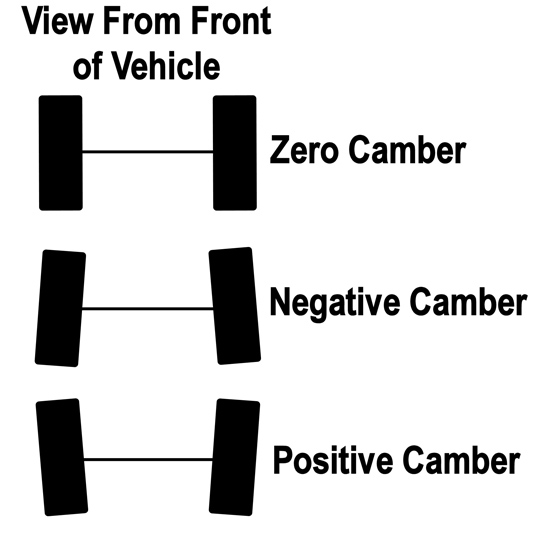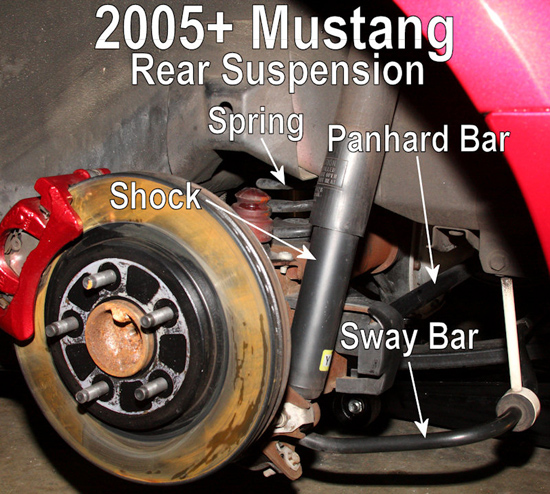Suspension Tech Guide - Part 1 - Typical Suspension Components
When someone first thinks of planning modifications, adding more horsepower or a change to the appearance are the things that come to mind. In many cases, the car’s suspension is the last thing an owner thinks about. That isn’t the way it should be. When it comes to making modifications, the suspension is just as important as the rest of the car.
To understand what changes are most beneficial to make to your suspension, you’ll need to have a basic understanding of the components involved and what they do. You’ll also want to know some common terminology. Once that has been addressed, it’s easier to decide what you may want to upgrade.
Common Suspension TermsCamber
Camber is how the tire leans when viewed from the front of the car. The top of the tire can either lean in slightly, lean out slightly, or be perfectly vertical. At first, you might think that a perfectly vertical tire orientation is preferred, but that is not always going to be the case. A little negative camber can enhance a vehicle’s cornering ability, allowing the outside tire to grip better in the corner, as the lower side of the tire will have a tendency to try and roll under as it turns. Positive camber is when the upper end of the tire leans out further than the bottom. Positive camber should be avoided, as it is detrimental to handling in nearly all cases. Zero camber is when the wheel and tire are perfectly straight, vertically.

Caster
Caster describes the relationship between the steering axis and a true vertical position. In the case of the Mustang, the steering axis is the strut. A higher caster angle gives a car more stability at higher speeds, although at slower speeds, the steering will feel heavier. Caster can also enhance the camber angle as the wheel is turned, giving you more grip in a turn.

Toe Angle
Toe angle refers to the relationship of the tires to one another, in regards to the direction they are pointed. Toe-in has the two tires pointing slightly together, while toe-out has them pointing slightly apart. A slight amount of toe-in helps higher speed stability, as the wheels will toe-out slightly as speeds increase.

Alignment
An alignment refers to a procedure that alters the camber, caster, and toe angle to make sure the vehicle is set correctly. What is considered “correct” can refer to factory specs, or, in the event of a race-prepped car, some more aggressive settings intended to help the suspension performance. Camber and caster are set at the front shock tower or the strut itself. Toe is adjusted via the steering tie rods. While you can alter the alignment at home, it’s best to take it to a shop that has the capability to accurately measure your front suspension adjustments
Major Suspension ComponentsA vehicle’s suspension involves several components, each serving an important task. As a whole, they all work together, giving the vehicle its handling characteristics. Knowing what these components are is the primary step to understanding how the suspension works.
Common Front Suspension Components- Lower Control Arms
- Springs
- Struts
- Sway Bar
- Wheel Spindle
The late model Mustang’s front suspension tends to be a bit more complicated than the rear, due to the steering rack and associated components. Up until 2004, struts and springs were mounted separately, with the spring closer to the engine. Beginning in 2005, the springs were mounted over the front struts, up in the top of the wheel well. The wheels spindle is mounted to the control arm, providing a point to mount the wheel and tire. A sway bar is used to connect the two control arms together, and is used to help control body roll.


Common Rear Suspension Components
- Axle Damper
- Panhard Bar
- Shocks
- Springs
- Sway Bar
- Upper Control Arm
Up until 2004, the late model Mustang used a four-link rear suspension. Two upper and two lower control arms hold the rear axle in place, giving the suspension its four-link moniker. Springs are used to support the rear of the car, above the axle, with separate shocks installed to control the dampening. Depending upon whether the Mustang is a V6 or V8, it has a 7.5 or an 8.8 inch rear end. The 7.5 uses an open differential, while the GT’s 8.8 inch rear end uses Ford’s Traction-Lok differential. The 8.8 inch rear end was also equipped with quad-shocks during these years, which help dampen the axle and reduce wheel hop. A sway bar is installed on both versions of the rear end to help control body roll.
The rear suspension underwent a significant change in the 2005 model year, in the form of how the rear axle is positioned under the car. The four-link suspension setup was nixed in favor of a three-link panhard bar setup. The panhard bar is tasked with the job of properly locating the rear axle from left to right. The change to this arrangement was a tradeoff between a full independent rear suspension and a solid axle. An independent rear suspension would have added a substantial cost to the initial price of the Mustang. In addition, many Mustang enthusiasts prefer a solid axle anyway, as it’s more suitable for dragstrip duties. The panhard bar setup still allows the Mustang to keep the solid axle, while providing cornering ability improvements that suit most owners better than previous generations of the Mustang.


Common Suspension Upgrades
Bushings
From the factory, Ford uses rubber bushings throughout the Mustang’s suspension. While rubber bushings aren’t the best option from a performance standpoint, they do help keep the cost down and provide a smoother ride by controlling what’s called NVH (Noise, Vibration, and Harshness). Keep in mind that a large number of Mustang owners never even really modify their car, so Ford’s use of rubber bushings makes sense in that regard. If you’re reading this, however, you’re not one of those people! You’re looking to improve your car in the way that suits you best.
If handling is a priority, then replacement bushings are the answer. While there are a few different types of materials available, the most commonly used option is polyurethane. Polyurethane will provide a much firmer feel than the factory rubber pieces and, when properly maintained, will outlast the stock components. Factory or replacement rubber bushings will tend to dry out and crack, due to their larger amount of flexibility and the natural properties of rubber as a material.
Bumpsteer KitsBumpsteer is a reference to the toe angle of the car. As the suspension travels in its up-and-down movement, the front of the tires will change slightly in their relation to one another. This is due to the tie rods traveling at a different rate than the control arms. There will always be some bumpsteer in a Mustang’s suspension, but this can be exaggerated if the car is lowered. The use of a bumpsteer kit will help eliminate this, by repositioning the tie rod ends.
Caster/Camber PlatesThe top of your front shock towers allow you to adjust the vehicle’s camber. If you’re looking to enhance handling, however, you’ll likely find that the adjustability allowed is minimal. This is especially true with lowered cars, in which case, there may simply not be enough adjustability offered at all. I’ve seen many factory stock Mustangs prior to 2005 that have alignment issues at the factory height, as the lack of adjustability can be that limited.
This is where caster/camber plates come in. Picking up where the factory adjustments options fall short, they give you a much greater range of adjustability for camber, while also adding the option to adjust your caster angle. So whether you’re looking to enhance your vehicle’s cornering ability, or bring it back into spec, a set of caster/camber plates is definitely a worthwhile investment.
Control ArmsIn addition to replacing minor suspension components, you can also start getting more advanced by replacing various control arms throughout the car. The front control arms are generally something that gets replaced on a vehicle that will see more serious track duty. Replacement front control arms can offer adjustability of roll center and bumpsteer. In the case of most Mustang owners, replacement of the rear control arms is a very useful upgrade.
Replacement upper and lower rear control arms allow you to bring the vehicle back into specs after lowering it. You can also replace the rear control arms to gain an edge in improving driveline traction. Control arms come in fixed or adjustable variations. The fixed arms are made for certain applications, while the adjustable options can be used in a multitude of situations and allow further fine-tuning if needed.
Shocks and StrutsShocks and struts are typically matched to a certain set of springs. As spring rates and ride heights change, so does the dampening needed from the shocks and struts. The springs' job is to support the vehicle, while the shocks and struts control the rebound of the spring, preventing the ride from being too bouncy and handling poorly. So the strength of the spring will dictate the action required from the shocks and struts. You can also change the shocks and struts while keeping the same springs, to control how the suspension reacts and handles, should you desire to have either a slightly looser or firmer feel.
SpringsReplacement springs serve two main purposes. They are: to alter the vehicle’s handling and to lower its stance. When replacing your springs, it’s wise to closely examine your needs. Are you looking to improve handling, and if so, by how much? If you want to lower your Mustang, how far do you want to go? The spring options and characteristics are nearly infinite, so properly planning a spring swap is important. For more information on changing springs, see Part 3 of this article series, which covers lowering your Mustang and a large amount of spring related information.
Sway BarsReplacement sway bars are used to help curtail body roll of a Mustang while cornering. As the body leans, grip is transferred from one side of the car to the other. While some weight transfer can be beneficial, too much can adversely affect handling. Keeping the car flatter in turns provides more even grip at the tires on both sides of the car, which helps to neutralize excessive oversteer. A car that leans too much will apply more traction to the wheels receiving more of the weight. This can unload the differential, and causes oversteer.
Want to Learn More About Your Suspension?
Suspension Tech Guide Part 2 - Bracing and Chassis Strengthening
Suspension Tech Guide Part 3 - Springs and Lowering Your Mustang






